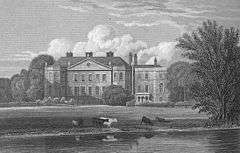Markeaton Hall
| Markeaton Hall | |
|---|---|
|
Markeaton Hall c.1829 | |
| General information | |
| Town or city | Markeaton, Derbyshire |
| Country | England |
| Construction started | 1750? |
| Completed | 1750? |
| Demolished | 1964 |
Markeaton Hall was an 18th-century country house at Markeaton, Derby, Derbyshire. It is one of the Lost houses of Derbyshire.
History
The manor of Markeaton was held by the Tuchet family from the 13th century.[1]
Sir John Tuchet (b.1327) married Joan, daughter of James Audley, 2nd Lord Audley and heiress of his brother Nicholas Audley, 3rd Lord Audley of Heleigh Castle, Staffordshire, and in due course their son became the 4th Lord Audley.[2]
Sir John Audley of Markeaton fought for Richard III of England at the Battle of Bosworth Field in 1485.[3]
The Tuchets sold the manor in 1516 to Sir John Mundy, Lord Mayor of the City of London in 1522. The Mundys replaced the old manor house with a new mansion in about 1750.[1]
Sir John Mundy's descendants included a number of High Sheriffs of Derbyshire including Francis Noel Clarke Mundy who commissioned paintings from Joseph Wright of Derby to decorate his home and record the hunts that took place at Markeaton. The family was known as Mundy of Markeaton until the early 20th century. Some of the direct descendants now use the surname Markeaton-Mundy. They include Simon Godfrey Mundy, Duke of Markeaton; Charles Markeaton-Mundy, Count of Mondaye who is Chancellor of Foreign Affairs of the Sovereign Military Hospitaller Order of St.John of Jerusalem, Ecumenical Knights of Malta; Sandra Markeaton-Mundy, Countess of Checkendon and Ivan and Charis Mundy
In 1929, the Markeaton Hall and twenty acres (81,000 m²) of its gardens were given to the Corporation by the Reverend Clarke Maxwell who had inherited the estate from the late Mrs Mundy, on condition that the whole area would be used as a public park and that the mansion would be maintained for cultural purposes, for example a museum or and art gallery. Unfortunately the hall was used by the Army during World War II and allowed to fall into disrepair after the war.
The Hall was eventually declared to be unsafe. and was demolished in 1964, leaving standing only the Orangery, a Grade II listed building[4]
References
- 1 2 Magna Britannia p202
- ↑ Magna Britannia pLXVII
- ↑ Roll Call of Battle of Bosworth
- ↑ EnglishHeritage: Heritage Gateway, architectural description of listed building
